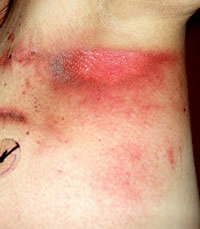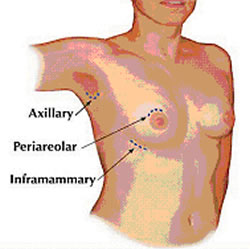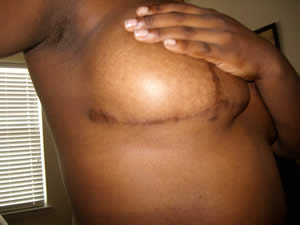Positive Health Online
Your Country

All Parts are Equal, or are They??
listed in bodywork, originally published in issue 199 - October 2012
When a person has back surgery or has had a limb amputated, it is standard for them to go through a rehabilitation process, including physical therapy or massage therapy to be prescribed. However, if a woman has breast surgery, rehabilitation (massage or physical therapy) is not automatically ordered and often not even suggested.
When a woman chooses to have her breasts removed, reconstructed, increased or reduced, it's important that she understands not only the benefits of the procedures, but the risks as well. Chronic pain and postural problems can appear years later if rehabilitation is not completed following breast surgery.
Breasts are composed of mammary glands, connective tissue, blood vessels, nerves, and lymph vessels. Breast tissue can extend from the border of the breastbone near the center of the chest all the way to the armpit, and overlies the second to sixth ribs. The breast has an axillary tail, which is a tail of tissue that extends up into the armpit region. The breast lies on top of the pectoralis major muscle.
Breast tissue is part of the fascial web of connective tissue, which runs continuously throughout the body from head to foot and superficial to deep without interruption. Any alteration, even the slightest damage to the fascial network has major ramifications.
The body's balance and symmetry can be significantly altered after a mastectomy, augmentation or reduction. This is something many women aren't informed of or prepared for. Scar tissue is also a very important fact which women need to be aware of and prepared for. Unpredictable development of scar tissue is quite common after any surgery and can have long-term effects on the body.
Early intervention following breast surgery by a massage or physical therapist can play a pivotal roll in helping women heal and regain full function.
After mastectomy surgery a woman may experience tightness or pulling originating from her incision, which spreads across her body. This is caused by scar tissue, which is the body's way of healing from surgery. The result can be very dense tissue under the incision, which is painful and which can restrict the arm's range of motion (ROM). The restricted ROM puts women at risk for a painful condition known as frozen shoulder. Scars can range in size after a breast-conserving lumpectomy or a mastectomy procedure that removes the entire breast. Either way, most breast cancer patients are left with some sort of surgical scar as a by-product of their quest to heal.
In order to rebuild the breast, tissue is taken from another area of the body. It can be taken from several different locations. One host area is the Latissimus Dorsi. In the picture below you can see how much of the body is affected by this location.
.jpg)
The TUG procedure uses skin and fat from the inner portion of the upper thigh; the incision scar will be hidden near the crease of the groin. The flap is named for the transverse upper gracilis muscle to which the skin and fat are connected. Muscle may be removed as part of the TUG flap.
.jpg)
Radiation treatment for Breast Cancer has its own list of complications. This type of therapy not only changes tissue characteristics by making it more susceptible to breakdown, it continues to make tissues tighter for 2 to 5 years following treatment.

It can also lead to:
- Skin tightening;
- Limited arm and shoulder mobility;
- Chest expansion limitations;
- Restrictions in and around the area of treatment.
Breast reduction surgery is still largely considered to be a cosmetic surgical procedure. However, it is most often performed to relieve significant physical and emotional problems resulting from overly large and/or heavy breasts. Surgeries are classified as “cosmetic” if it is an elective procedure that insurance does not cover. If it is a procedure that is restoring form or function, it’s referred to as “reconstructive”. Reconstructive procedures are often covered by insurance. The same procedure may be classified as cosmetic or reconstructive depending on how it impacts an individual. Public opinion still sees it as cosmetic but 9.5 times out of ten it is being performed to reduce pain or to alter the overall structure.
According to the American Society of Aesthetic Plastic Surgery, 112,964 breast reductions were performed in 2011. Breast reduction surgery leaves permanent scarring.

The operation using the anchor technique leaves three scars:
- One around the nipple (areola);
- One from the nipple to the crease below the breast (this is the worst scar as it takes the most tension);
- One from the breast bone to the armpit along the crease below the breast.

The severity of scarring largely depends on the individual. Most women are completely unaware of how the scar tissue is affecting them.
Kelly Bowers, a massage therapist from Washington, DC states:
"I had breast reduction surgery in 1992. By 2012 I rarely thought of it and certainly didn't think the scars were an issue any more. They were barely visible! Then I had scar release work. I was stunned at how far I felt the effects of the work. I felt it from my shoulder to my hip! I'm delighted I had a chance to experience this work and finally take care of these scars as they deserved to be taken care of."
The American Society for Aesthetic Plastic Surgery also reported that breast augmentation is the most popular surgical cosmetic procedure for women, with more than 316,000 procedures performed in 2011. Yes, augmentation is an elective cosmetic surgery, but it is still a surgery that alters the body. Rehabilitative therapy is necessary after any surgery.
Women who have breast augmentation frequently experience:
- Limited upper extremity mobility (range of motion);
- Arm weakness and swelling;
- Fatigue;
- Shoulder dysfunction;
- Back pain;
- Chest pain.
Scar tissue can occur at any time after the augmentation has been performed, not just within the first few months. Capsular contracture is the term used to describe scar tissue that can form around breast implants which may cause the breasts to harden, look or feel different, and may cause some discomfort from the tightening of the capsule. Capsular contracture is an unpredictable complication, but it is also the most common complication following breast augmentation.
Scars left by breast augmentation surgery are usually hidden in the crease beneath the breast (inframammary fold incision), around the nipple (peri-areolar incision) or in the armpit (transaxillary incision).
Rehabilitation/therapy and physical activity are integral to recovery and to reduce post-breast surgery side effects such as:
- Scar tissue/soft tissue immobility;
- Flexibility limitations;
- Limited range of motion;
- Decreased strength.
Even if a woman does not actually develop pain or limited function directly after the procedure, at some point pain and disability will become present if scar tissue is not addressed in a timely and proper fashion.
Comments:
-
Marsha Brett said..
I live in Framingham Ma. I need a PT who specializes in breast massage to break down capsulated contracture
After implant. Can you recommend someone?a